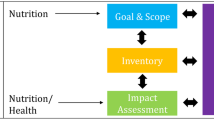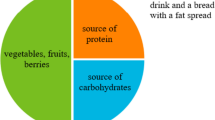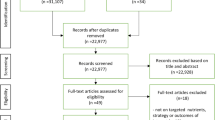Abstract
Purpose
This work provides an unambiguous conceptual framework for inclusion of nutrition in Life Cycle Assessments (LCAs) of food that enables the distinction between two different roles of nutrition, namely serving as the basis of food comparisons via the functional unit and as an impact pathway that links food ingestion with human health effects.
Methods
We compare how nutritional aspects have been considered in the functional unit of published LCAs of food with the procedural requirements for ensuring comparability of the functional units. We consider the relevance of nutrient profiling models for assessing food- and diet-related health damages and benefits in the context of LCAs of food. We finally recommend a method that will enable a systematic, comparative, and holistic assessment of the marginal health effect of food products on human health.
Results and discussion
Satiety is proposed as a central attribute for comparisons of food products, while weighted measures of nutrient content are suggested to be largely misplaced as part of the functional unit. In contrast, nutritional measures have a large role to play in assessing the human health impacts of the marginal ingestion of specific food products. Such measures should enable a direct quantification of human health effect and benefits and should take advantage of robust epidemiological evidence.
Conclusions
Nutritional measures enter into both the functional unit in the form of satiety measures and into the calculation of impacts in the form of the marginal influence of the specific food item on the human health impact of the overall diet. To enhance the differentiation of health impacts at the level of individual food items, it is recommended to combine the nutrient balance indicator with the DALY Nutritional Index (DANI) in each specific dietary context.

Similar content being viewed by others
References
Arsenault JE, Fulgoni VL III, Hersey JC, Muth MK (2012) A novel approach to selecting and weighting nutrients for nutrient profiling of foods and diets. J Acad Nutr Diet 112(12):1968–1975
Arvaniti F, Panagiotakos DB (2008) Healthy indexes in public health practice and research: a review. Crit Rev Food Sci 48(4):317–327
Beales II JH, Pahl TB, Rozell L, Froeb L, Ippolito PM, Murphy DR, Zywicki T, Ohlhausen MK (2004) Comments of the Staff of the US Federal Trade Commission on Nutrient Content Claims General Principles; Health Claims, General Requirements and Other Specific Requirements for Individual Health Claims, Docket Nos. 1994P-0390 and 1995P-0241. https://www.ftc.gov/sites/default/files/documents/advocacy_documents/ftc-staff-comment-food-and-drug-administration-concerning-nutrient-claims/v040020.pdf [Accessed 2019-05-13]
Bruun Werner L, Flysjö A, Tholstrup T (2014) Greenhouse gas emissions of realistic dietary choices in Denmark: the carbon footprint and nutritional value of dairy products. Food Nutr Res 58:1–16
Chambers L, McCrickerd K, Yeomans MR (2015) Optimising foods for satiety. Trends Food Sci Technol 41(2):149–160
van Dooren C (2016) Proposing the nutrient density unit as the functional unit in LCAs of foods. International Conference on Life Cycle Assessment of Food, Dublin
van Dooren C, Douma A, Aiking H, Vellinga P (2017) Proposing a novel index reflecting both climate impact and nutritional impact of food products. Ecol Econ 131:389–398
Drewnowski A, Fulgoni VL III (2008) Nutrient profiling of foods: creating a nutrient-rich food index. Nutr Rev 66(1):23–39
Fern EB, Watzke H, Barclay DV, Roulin A, Drewnowski A (2015) The nutrient balance concept: a new quality metric for composite meals and diets. PLoS One 10(7):e013049
Forouzanfar MH et al (2016) Global, regional, and national comparative risk assessment of 79 behavioural, environmental and occupational, and metabolic risks or clusters of risks, 1990–2015: a systematic analysis for the Global Burden of Disease Study 2015. Lancet 388:1659–1724
Fulgoni VL III, Wallace TC, Stylianou KS, Jolliet O (2018) Calculating intake of dietary risk components used in the Global Burden of Disease Studies from the What We Eat in America/National Health and Nutrition Examination Surveys. Nutrients 10(10):1441–1455
Gakidou E et al (2017) Global, regional, and national comparative risk assessment of 84 behavioural, environmental and occupational, and metabolic risks or clusters of risks, 1990–2016: a systematic analysis for the Global Burden of Disease Study 2016. Lancet 390:1345–1422
Heller MC, Keoleian GA, Willett WC (2013) Toward a life cycle-based, diet-level framework for food environmental impact and nutritional quality assessment: a critical review. Environ Sci Technol 47(22):12632–12647
Hopkins M, Blundell J, Halford J, King N, Finlayson G (2016) The regulation of food intake in humans. https://www.ncbi.nlm.nih.gov/books/NBK278931/. Accessed 2018-02-27
IES (2010) Specific guide for Life Cycle Inventory data sets. International Reference Life Cycle Data System (ILCD) Handbook. Institute for Environment and Sustainability (IES), Joint Research Centre of the European Commission. Luxembourg: Publications Office of the European Union. EUR 24709 EN
Imamura F, Micha R, Khatibzadeh S, Fahimi S, Shi P, Powles J, Mozaffarian D (2015) Dietary quality among men and women in 187 countries in 1990 and 2010: a systematic assessment. Lancet Glob Health 3(3):e132–e142
van Kernebeek HRJ, Oosting SJ, Feskens EJM, Gerber PJ, De Boer IJM (2013) The effect of nutritional quality on comparing environmental impacts of human diets. J Clean Prod 73:88–99
Lee JE, McLerran DF, Rolland B, Chen Y, Grant EJ, Vedanthan R, Inoue M, Tsugane S, Gao YT, Tsuji I, Kakizaki M (2013) Meat intake and cause-specific mortality: a pooled analysis of Asian prospective cohort studies. Am J Clin Nutr 98(4):1032–1041
McCullough ML, Willett WC (2006) Evaluating adherence to recommended diets in adults: the Alternate Healthy Eating Index. Public Health Nutr 9(1a):152–157
Mozaffarian D (2017) Foods, nutrients, and health: when will our policies catch up with nutrition science? Lancet Diabetes Endocrinol 5(2):85–88
Sacks G, Rayner M, Swinburn B (2009) Impact of front-of-pack ‘traffic-light’ nutrition labelling on consumer food purchases in the UK. Health Promot Int 24:344–352
Sonesson U, Davis J, Flysjö A, Gustavsson J, Witthöft C (2017) Protein quality as functional unit - a methodological framework for inclusion in life cycle assessment of food. J Clean Prod 140:470–478
Stylianou KS (2018) Nutritional and environmental impacts of foods on human health. Dissertations & Theses @ University of Michigan. https://deepblue.lib.umich.edu/handle/2027.42/147641. Accessed 2019-05-13
Stylianou KS, Heller MC, Fulgoni VL III, Ernstoff AS, Keoleian GA, Jolliet O (2016) A life cycle assessment framework combining nutritional and environmental health impacts of diet: a case study on milk. Int J Life Cycle Assess 21(5):734–746
Stylianou S, Fulgoni III VL, Jolliet O (2019) HENI: a health burden-based nutritional index for food items. (Submitted for publication)
Weidema BP (2017) Short procedural guideline to identify the functional unit for a product environmental footprint and to delimit the scope of product categories. 2.-0 LCA consultants, report to the Nordic Council of Ministers. http://lca-net.com/p/2527 [Accessed 2018-02-27]
Acknowledgements
The authors would like to gratefully acknowledge Olivier Jollliet and Victor L Fulgoni III for providing access to data from the DALY Nutritional Index.
Author information
Authors and Affiliations
Corresponding author
Additional information
Responsible editor: Bruno Notarnicola
Publisher’s note
Springer Nature remains neutral with regard to jurisdictional claims in published maps and institutional affiliations.
Rights and permissions
About this article
Cite this article
Weidema, B.P., Stylianou, K.S. Nutrition in the life cycle assessment of foods—function or impact?. Int J Life Cycle Assess 25, 1210–1216 (2020). https://doi.org/10.1007/s11367-019-01658-y
Received:
Accepted:
Published:
Issue Date:
DOI: https://doi.org/10.1007/s11367-019-01658-y




